In the realm of gardening, where creativity meets nature, best hanging basket trailing plants emerge as captivating stars. These botanical wonders, with their graceful cascades and vibrant blooms, transform outdoor spaces into enchanting oases.
From the delicate charm of petunias to the dramatic flair of fuchsia, a myriad of trailing plants awaits discovery, each promising a unique contribution to your hanging basket designs.
Best Trailing Plants for Hanging Baskets
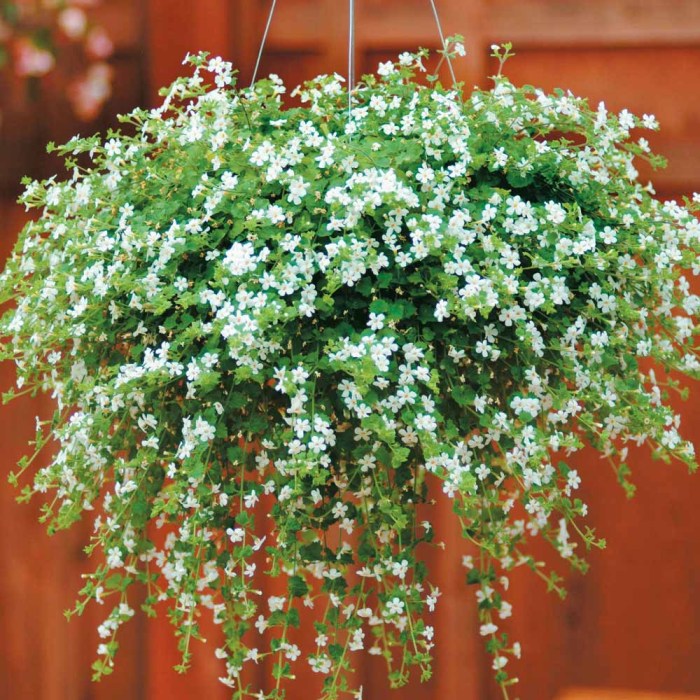
Trailing plants are a beautiful and easy way to add color and interest to your hanging baskets. They can cascade over the sides of the basket, creating a lush and inviting display. When choosing trailing plants for hanging baskets, there are a few things to keep in mind.
First, consider the size of the basket. You want to choose plants that will not overwhelm the basket or grow too leggy. Second, think about the growth habit of the plants. Some plants will trail naturally, while others will need to be pinched back to encourage trailing.
Finally, consider the flowering characteristics of the plants. Some plants will bloom profusely, while others will produce only a few flowers.
Best hanging basket trailing plants are a beautiful way to add a touch of nature to your home. They can be used to create a lush, tropical atmosphere in any room, and they’re also a great way to add some color and life to your bedroom.
For those looking to add some greenery to their bedroom, a bedroom plant hanger is a perfect solution. These hangers are designed to hold plants securely, and they can be hung from the ceiling or from a wall. They’re a great way to add some vertical interest to your bedroom, and they can also help to purify the air.
Once you’ve chosen the perfect plants and hangers, you can enjoy the beauty of nature in your own home.
Here is a list of the most popular trailing plants for hanging baskets:
Petunias
- Botanical name: Petunia x hybrida
- Common name: Petunia
- Key features: Petunias are one of the most popular trailing plants for hanging baskets. They are easy to grow and come in a wide range of colors. Petunias bloom profusely from spring to fall.
Million Bells
- Botanical name: Calibrachoa x hybrida
- Common name: Million Bells
- Key features: Million Bells are a relatively new type of trailing plant that has become very popular in recent years. They are similar to petunias, but they have smaller flowers and a more compact growth habit. Million Bells bloom profusely from spring to fall.
Verbena
- Botanical name: Verbena x hybrida
- Common name: Verbena
- Key features: Verbena is a versatile trailing plant that can be used in hanging baskets, window boxes, and other containers. It is easy to grow and comes in a wide range of colors. Verbena blooms profusely from spring to fall.
Trailing Lobelia, Best hanging basket trailing plants
- Botanical name: Lobelia erinus
- Common name: Trailing Lobelia
- Key features: Trailing Lobelia is a delicate trailing plant that is perfect for small hanging baskets. It has small, bell-shaped flowers that come in a variety of colors. Trailing Lobelia blooms profusely from spring to fall.
Trailing Geraniums
- Botanical name: Pelargonium peltatum
- Common name: Trailing Geraniums
- Key features: Trailing Geraniums are a classic choice for hanging baskets. They are easy to grow and come in a wide range of colors. Trailing Geraniums bloom profusely from spring to fall.
Choosing the Right Plants for Your Hanging Baskets
Selecting the perfect trailing plants for your hanging baskets requires careful consideration of several key factors. These include sun exposure, water requirements, and companion planting. By taking these factors into account, you can create stunning arrangements that will thrive and add beauty to your outdoor space.
Sun Exposure
The amount of sunlight your hanging baskets receive will significantly influence the types of plants you can grow. Plants that prefer full sun, such as petunias and geraniums, will need to be placed in baskets that receive at least six hours of direct sunlight per day.
Plants that prefer partial shade, such as impatiens and begonias, can tolerate less sunlight, making them suitable for baskets that receive morning or afternoon sun.
Water Requirements
The frequency with which you water your hanging baskets will depend on the water needs of the plants you choose. Some plants, such as lobelia and verbena, require frequent watering, while others, such as lantana and rosemary, can tolerate drier conditions.
It’s important to match the water requirements of your plants to your watering habits to ensure they receive the moisture they need to thrive.
Companion Planting
When selecting plants for your hanging baskets, it’s also important to consider companion planting. Companion planting involves pairing plants that benefit each other when grown together. For example, planting petunias and nasturtiums together can help deter pests, while planting marigolds and basil can improve the growth of both plants.
Planting and Care for Hanging Baskets: Best Hanging Basket Trailing Plants
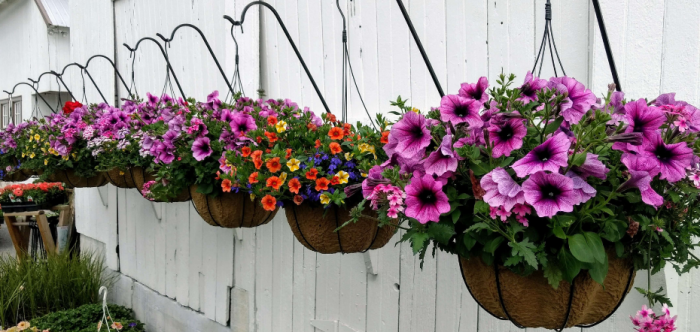
Proper planting and meticulous care are essential to maintain the health and beauty of trailing plants in hanging baskets. These plants thrive in well-drained soil, and regular watering, fertilization, and pruning contribute to their optimal growth and vibrant appearance throughout the growing season.
Soil Preparation
For optimal growth, choose a potting mix specifically formulated for hanging baskets, ensuring proper drainage and aeration. Amend the potting mix with organic matter such as peat moss or compost to enhance moisture retention and provide essential nutrients.
Planting
Before planting, soak the plants in water for several hours to rehydrate their roots. Create a hole in the potting mix large enough to accommodate the plant’s root ball without bending or damaging the roots. Gently place the plant in the hole and backfill with potting mix, firming it around the base of the plant.
Watering
Hanging basket plants require regular watering, especially during hot and dry weather. Allow the top inch of soil to dry out between waterings, then water thoroughly until excess water drains from the bottom of the basket. Avoid overwatering, as it can lead to root rot.
If you’re looking for a way to add some life to your home, hanging plants are a great option. They can add a touch of greenery and freshness to any room, and they’re also a great way to improve air quality.
Best hanging basket trailing plants are perfect for adding a splash of color and interest to your home. They’re also a great way to add some greenery to your home without taking up too much space. For more inspiration on how to incorporate hanging plants into your home decor, check out our article on beautiful hanging indoor plants . Whether you’re looking for a trailing plant to add some drama to your living room or a smaller plant to brighten up your kitchen, you’re sure to find the perfect one for your home.
Fertilizing
Fertilize hanging basket plants every two to three weeks during the growing season with a balanced liquid fertilizer diluted to half strength. Apply the fertilizer according to the manufacturer’s instructions.
Pruning
Regular pruning encourages bushy growth and prevents the plants from becoming leggy. Pinch back the tips of stems to promote branching and fullness. Remove any dead or damaged leaves or stems to maintain the health and appearance of the plants.
Designing Stunning Hanging Basket Arrangements
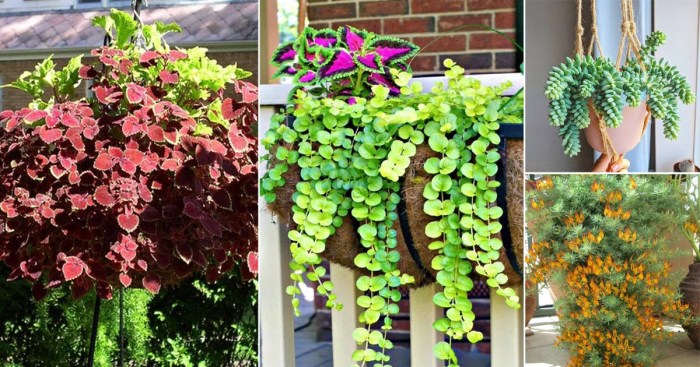
Hanging baskets offer a vertical dimension to gardening, allowing you to create eye-catching displays that cascade with greenery and blooms. To design stunning hanging basket arrangements, consider the following principles:
- Color Theory:Combine plants with complementary colors for a vibrant display, or opt for monochromatic arrangements for a more subtle effect.
- Texture:Play with different leaf textures to add visual interest, mixing smooth, velvety leaves with frilly or serrated ones.
- Balance:Distribute plants evenly around the basket to create a harmonious arrangement. Consider the weight and height of each plant to ensure stability.
Examples of Hanging Basket Arrangements
Here are some creative hanging basket arrangements to inspire you:
-
-*Tropical Oasis
Combine colorful trailing plants like trailing begonias, ferns, and variegated ivy to create a lush, tropical atmosphere.
-*Floral Cascade
For those looking to add a touch of greenery to their outdoor space, consider the best hanging basket trailing plants. These plants can create a stunning display, cascading over the sides of containers and adding a touch of elegance to any patio or balcony.
Whether you prefer the delicate blooms of lobelia or the lush foliage of ivy, there are plenty of options to choose from. For more information on hanging plants, visit Hanging Plants Indoor . The site offers a comprehensive guide to the best hanging basket trailing plants, providing tips on care and maintenance to ensure your plants thrive.
Plant a mix of flowering plants such as petunias, calibrachoa, and lobelia to create a vibrant floral waterfall.
-*Edible Garden
Plant herbs like basil, thyme, and oregano to create a hanging edible garden that’s both beautiful and practical.
-*Vertical Succulent Garden
Combine different succulents in a hanging basket for a low-maintenance, drought-tolerant display.
If you’re looking for the best hanging basket trailing plants, you’ll want to consider the cascading varieties. These plants have long, flowing stems that can create a beautiful waterfall effect. Some of the best cascading house plants include the spider plant, the pothos, and the ivy.
These plants are all easy to care for and can tolerate a variety of light conditions. For more information on the best cascading house plants, visit best cascading house plants .
-*Mixed Media
Incorporate decorative elements like shells, stones, or figurines into your hanging basket arrangement to add a personal touch.
Troubleshooting Common Problems
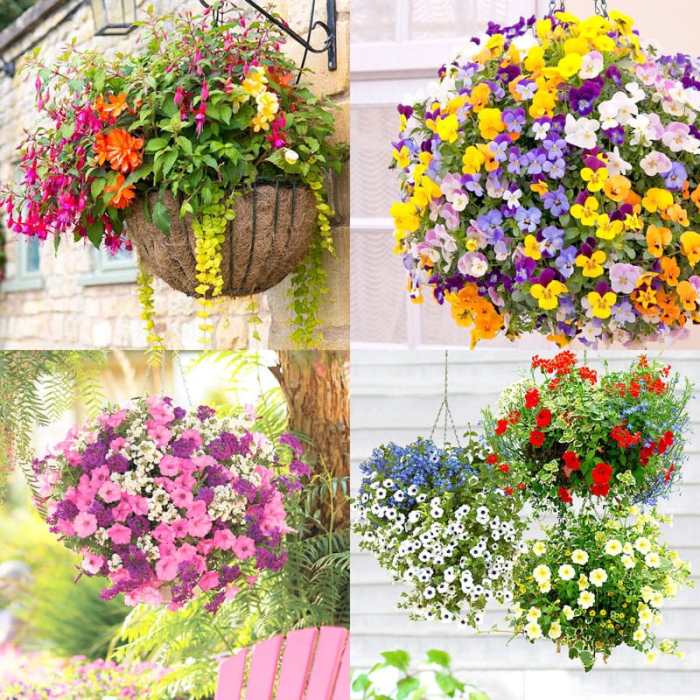
When growing trailing plants in hanging baskets, you may encounter common problems such as pests, diseases, and nutrient deficiencies. These issues can affect the health and appearance of your plants, but they can be managed with proper care and preventive measures.
Pests
Insects like aphids, spider mites, and whiteflies can infest hanging baskets, causing damage to leaves and stems. To prevent infestations, regularly inspect your plants for pests and treat them promptly with insecticidal soap or neem oil. Encourage beneficial insects like ladybugs and lacewings to your garden, as they prey on common pests.
Diseases
Fungal diseases such as powdery mildew and botrytis can thrive in the moist environment of hanging baskets. To prevent diseases, ensure proper drainage and avoid overwatering. Remove infected leaves and stems promptly, and apply fungicides if necessary.
Nutrient Deficiencies
Trailing plants in hanging baskets may suffer from nutrient deficiencies due to limited root space. To prevent this, fertilize your plants regularly with a balanced liquid fertilizer. Use a slow-release fertilizer to provide nutrients over an extended period.
Epilogue
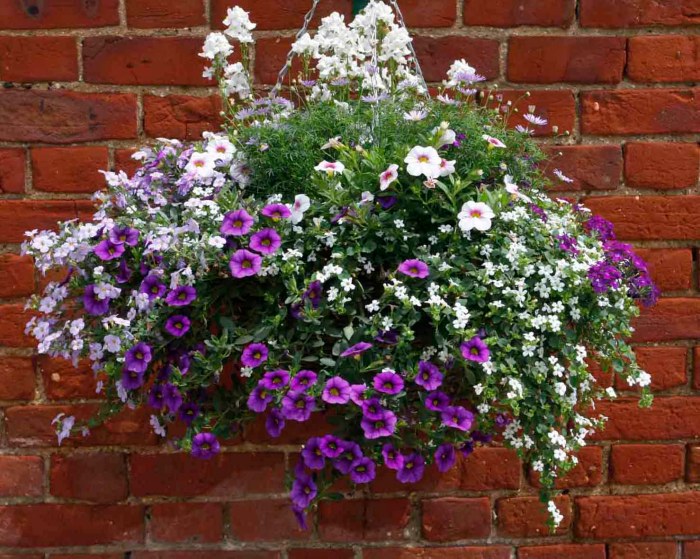
Embark on a horticultural journey as we delve into the world of best hanging basket trailing plants. Discover the secrets to selecting the perfect companions, nurturing them to vibrant health, and crafting stunning arrangements that will leave a lasting impression.
Clarifying Questions
What are the essential traits of ideal trailing plants for hanging baskets?
Compact size, vigorous growth habit, and a profusion of flowers are key characteristics to look for.
How do I choose the right trailing plants for my hanging baskets?
Consider factors such as sun exposure, water requirements, and the desired visual effect when selecting plants.
What are some tips for maintaining healthy trailing plants in hanging baskets?
Regular watering, proper drainage, and occasional fertilization are crucial for thriving plants.